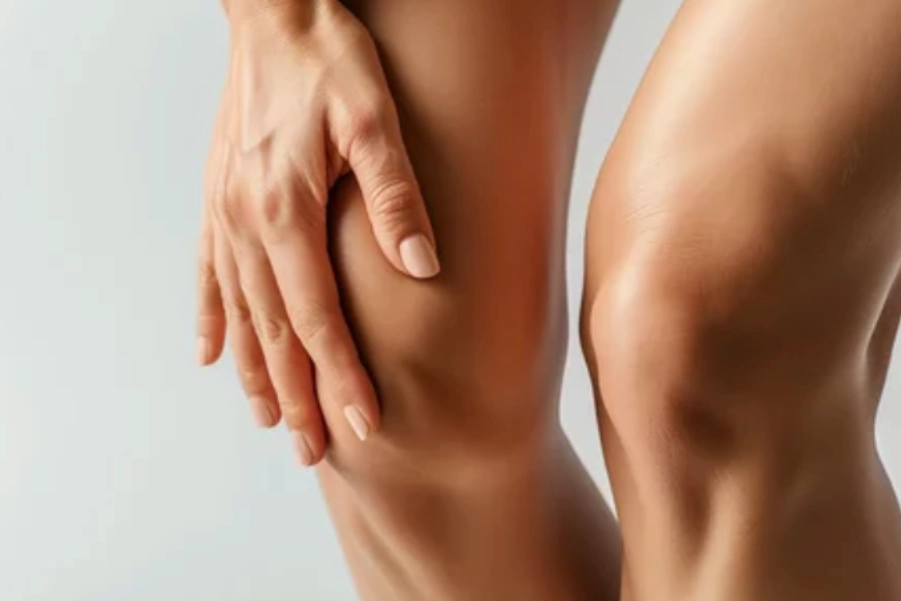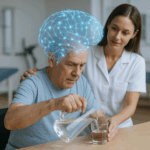Physiotherapy Treatment Protocol for Infrapatellar Tendinitis (Jumper’s Knee)
Overview of Conditions:
Infrapatellar Tendinitis, commonly known as Jumper’s Knee, is a condition marked by pain and inflammation of the infrapatellar tendon, which connects the patella to the tibia. This condition is particularly common among athletes involved in high-impact sports such as basketball, volleyball, and running. It results from repetitive loading of the tendon, leading to microtears and degeneration over time. Biomechanical issues such as muscle imbalances, improper technique, or inadequate warm-up can also contribute to the condition.
Etiology:
- Repetitive Loading: Activities like jumping or squatting place repetitive stress on the patellar tendon, causing microtears and inflammation.
- Tendinopathy: Chronic overuse can lead to tendinopathy, where tendon fibers become disorganized and weaker.
- Biomechanical Factors: Weakness in the quadriceps, particularly the vastus medialis oblique (VMO), tightness in the quadriceps, hamstrings, or calf muscles, and abnormal postural alignment can contribute to the overload on the tendon.
Assessment and Evaluation:
History:
- Pain Characteristics: Pain is typically localized just below the patella and worsens with activities that load the knee joint (e.g., jumping, running, squatting).
- Onset: The pain usually develops gradually, often after an increase in the intensity or frequency of physical activity.
- Previous History: Any history of knee injuries, such as trauma or prior tendinitis, should be assessed.
Physical Examination:
- Observation: Look for swelling or thickening in the infrapatellar region and signs of muscle atrophy, particularly in the quadriceps.
- Palpation: Tenderness at the inferior pole of the patella, where the tendon attaches, is common.
- Range of Motion (ROM): Assess knee flexion and extension to rule out joint involvement.
- Strength Testing: Evaluate quadriceps strength, especially the VMO, and check for hamstring weakness.
- Special Tests: The Patellar Tendon Palpation Test and Eccentric Load Test can help assess tendon pain and functionality.
Biomechanical Assessment:
- Postural Alignment: Evaluate for any abnormal foot pronation, knee valgus (knock-knees), or hip weakness, which could alter loading patterns on the patellar tendon.
- Gait Analysis: Observe the patient’s walking and running patterns, especially during activities like jumping and landing.
Goal Setting:
Short-Term Goals (0-4 weeks):
- Pain Reduction: Reduce pain to a manageable level (VAS ≤ 3) during daily activities.
- Swelling Control: Use ice therapy and elevation to manage swelling.
- Restore ROM: Ensure full knee flexion and extension without significant pain.
- Initiate Strengthening: Begin quadriceps strengthening, especially targeting the VMO, and stretch the hamstrings.
Long-Term Goals (4-12 weeks):
- Strength and Function: Achieve 80-90% quadriceps strength compared to the unaffected leg.
- Restore Tendon Integrity: Promote collagen repair and normalize patellar tendon loading through progressive exercise and activity modification.
- Return to Sport: Gradually return to jumping and running activities without pain.
- Prevent Recurrence: Develop a maintenance program focusing on flexibility, strength, and proper biomechanics.
Recommended Treatment:
Electrotherapy:
- Transcutaneous Electrical Nerve Stimulation (TENS):
- Indication: Pain relief and reduction of muscle spasms in the acute phase.
- Parameters: Frequency 80-120 Hz, Pulse Width 100-300 µs, Duration 20-30 minutes, 2-3 times per day.
- Mechanism: TENS modulates pain by stimulating sensory nerves and blocking pain signals.
- Interferential Therapy (IFT):
- Indication: Pain reduction and promotion of tendon healing.
- Parameters: Carrier frequency 4,000 Hz modulated at 80-150 Hz, Duration 20-30 minutes.
- Mechanism: IFT penetrates deeper tissues, reducing pain and inflammation by stimulating the body’s natural healing mechanisms.
- Ultrasound Therapy:
- Indication: Tendon healing and inflammation reduction.
- Parameters: Frequency 1 MHz, Intensity 1.0-1.5 W/cm², Duration 8-10 minutes.
- Mechanism: Ultrasound promotes collagen production and improves tissue extensibility, aiding tendon healing.
- Class 4 LASER Therapy:
- Indication: Pain relief, inflammation reduction, and stimulation of tissue repair.
- Parameters: Wavelength 800-900 nm, Power 5-10 W, Duration 5-10 minutes per area.
- Mechanism: LASER therapy stimulates fibroblasts, collagen production, and accelerates tendon regeneration.
Thermotherapy:
- Moist Heat Packs:
- Indication: To reduce stiffness and improve muscle flexibility.
- Application: Apply moist heat for 15-20 minutes before exercises.
- Mechanism: Heat promotes circulation and prepares tissue for further rehabilitation.
Manual Therapy:
- Soft Tissue Mobilization (Myofascial Release):
- Indication: Release tightness in quadriceps, hamstrings, and IT band, which may contribute to abnormal patellar loading.
- Technique: Apply gentle pressure along the tendon and surrounding muscles, followed by passive stretching of the quadriceps and hamstrings.
- Mechanism: Myofascial release alleviates muscle tension, improving flexibility and reducing strain on the tendon.
Exercise Therapy:
- Eccentric Strengthening of the Quadriceps:
- Exercise: Eccentric quadriceps exercises such as squats, lunges, and step-downs.
- Duration: 3 sets of 10-15 repetitions, 2-3 times per week.
- Mechanism: Eccentric exercises promote tendon healing by stimulating collagen synthesis and proper tendon alignment.
- Hamstring Stretching:
- Exercise: Gentle hamstring stretches to reduce tightness.
- Duration: Hold for 30-45 seconds, repeat 2-3 times per muscle group.
- Mechanism: Stretching helps alleviate lower limb tension, promoting normal knee mechanics.
- Patellar Tendon Loading:
- Exercise: Gradually load the patellar tendon through controlled exercises, starting from isometric to dynamic exercises.
- Duration: 3 sets of 10-15 repetitions, 2-3 times per week.
- Mechanism: Controlled loading restores tendon function and strength.
- Hip and Glute Strengthening:
- Exercise: Strengthen hip abductors and gluteal muscles (e.g., clamshells, bridges).
- Duration: 3 sets of 10-15 repetitions, 2-3 times per week.
- Mechanism: Strengthening the hips improves lower limb alignment, reducing abnormal loading on the patellar tendon.
Precautions:
- Avoid High-Impact Activities: Refrain from activities like running, jumping, or heavy squatting in the early phases of rehabilitation.
- Monitor Pain Levels: Keep pain below 3 on the Visual Analog Scale (VAS). If pain increases, reduce intensity or modify exercises.
- Avoid Overloading: Gradually increase the intensity and volume of exercises to prevent tendon overload.
Reassessment and Criteria for Progression/Change in Care Plan:
Reassessment:
- Pain and Function: Monitor pain levels (VAS) and functional limitations, aiming for significant improvement by 4-6 weeks.
- Strength: Reassess quadriceps and hamstring strength every 4 weeks. Once strength reaches 80-90% of the unaffected leg, progress to dynamic activities.
- Functional Tests: Perform tests such as squatting, jumping, and running to assess functional recovery.
Criteria for Progression:
- Pain Reduction: Progress to dynamic exercises (plyometrics and sport-specific drills) once pain is under control.
- Strength and ROM: Once strength and ROM reach functional levels, increase activity intensity.
- Return to Sport: Ensure pain-free jumping and running before returning to sport.
Disclaimer and Note:
Treatment options should be chosen wisely and appropriately. For example, where multiple options are recommended (such as in electrotherapy), any one option can be selected based on availability and appropriateness. Consultation with a qualified healthcare provider is advised for a tailored treatment plan. This content is for informational purposes only.
References:
- Lian, O. B., et al. (2022). “Patellar tendinopathy in athletes: Current management and rehabilitation strategies.” European Journal of Sports Science, 22(7), 981-990. https://doi.org/10.1080/17461391.2022.2075874
- Roos, E. M., et al. (2023). “Eccentric exercise and electrotherapy in patellar tendinopathy: A systematic review.” Journal of Orthopaedic & Sports Physical Therapy, 53(8), 453-461. https://doi.org/10.2519/jospt.2023.10613
- Godfrey, L. P., et al. (2020). “Laser therapy and ultrasound therapy in the management of patellar tendinopathy.” British Journal of Sports Medicine, 54(6), 380-389. https://doi.org/10.1136/bjsports-2019-100626






